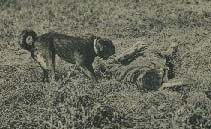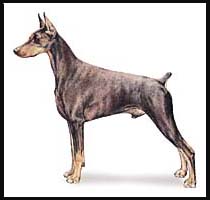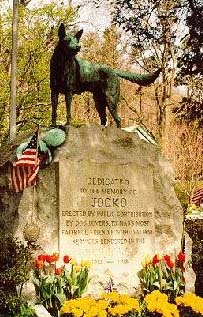
Historical Tales | News | Vampires | Zombies | Werewolves
Virtual Academy | Weapons | Links | Forum
Dogs
 |
| A dog drags a dead zombie out of the brush |
Dogs were used in vampire control as far back as 2000 BC, when rulers of the Hittite Empire in Asia Minor were said to keep vampire-fighting dogs "as large and fierce as lions." Although many dog breeders attempted to create a dog that was effective against both vampires and zombies, most breeders found it best to breed different dogs for different nemeses. Thus, large, powerful dogs were bred for zombie control, while vampire-fighting dogs tended to be from faster and more agile varieties. Many of these breeds developed by different countries for undead control are still popular today, such as the Tosa-Inu of Japan and the Tibetan Mastiff from China. German Shepherds were one of the few dogs often used against both vampires and zombies.
 |
| The Doberman Pinscher, vampire hunter supreme |
Vampires and zombies reacted differently to dogs. Vampires generally tried to flee, using their athleticism and leaping ability to outpace the dogs. Zombies, on the other hand, would stand and fight. While zombies had no answer for dogs, vampires took to fighting fire with fire by breeding their own dogs for protection. Several well-known breeds of today were actually created by vampires. An example of this is the Rhodesian Ridgeback, which a South African vampire pack created by breeding a native shepherd dog with Mastiffs imported by white settlers.
In the United States, the FVZA used dogs on an informal basis for decades before the official establishment of the K-9 division in 1925. The Agency's vampire-fighting breed of choice was the Doberman, while Rottweilers and Mastiffs were used against zombies. At the training facility in Kentucky, trainers used clothing taken off vampires and zombies to acclimate the dogs to the smell of the undead. Doberman training focused on pursuit and capture, while Mastiffs and Rottweilers training focused on in-close fighting.
 |
| The Jocko memorial in Chicago |
One of the most heralded dogs in FVZA history was Jocko, a mutt who served in the Chicago Bureau. Jocko was adopted as a stray pup by agent Paul McDermott. Though not of a vampire-fighting breed, Jocko showed such a natural facility for vampire-hunting that he was put on the force. The dog went on to serve with distinction for eight years. On January 23, 1934, just a few days before his retirement, Jocko chased down a vampire trying to flee with a child. The brave animal locked on to the vampire's lower leg, forcing the vampire to release the child unharmed. But when other vampire pack members rushed him, Jocko sustained a bite and had to be put down. Over a million people braved frigid weather to attend the dog's funeral.